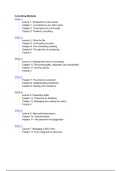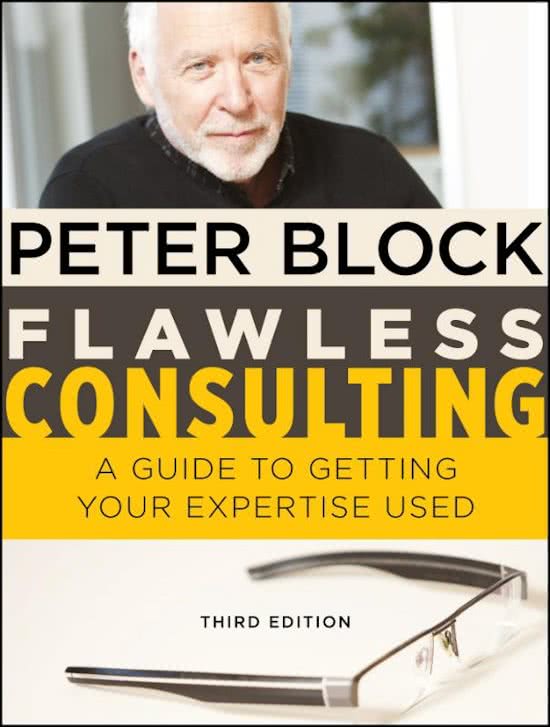Consulting Methods
Week 1:
- Lecture 1: Introduction to the course
- Chapter 1: Consultant by any other name
- Chapter 2: Techniques are not enough
- Chapter 3: Flawless consulting
Week 2:
- Lecture 2: Client for life
- Chapter 4: Contracting overview
- Chapter 5: The contracting meeting
- Chapter 6: The agonies of contracting
- Tutorial 2
Week 3:
- Lecture 3: Shaping the future of consulting
- Chapter 12: Discovering gifts, capacities, and possibilities
- Chapter 13: Get the picture
- Tutorial 3
Week 4:
- Chapter 7: The internal consultant
- Chapter 8: Understanding resistance
- Chapter 9: Dealing with resistance
Week 5:
- Lecture 5: Presenting skills
- Chapter 14: Preparing for feedback
- Chapter 15: Managing the meeting for action
- Tutorial 5
Week 6:
- Lecture 6: High performing teams
- Chapter 16: Implementation
- Chapter 17: The elements of engagement
Week 7:
- Lecture 7: Managing a BIG 4 firm
- Chapter 10: From diagnosis to discovery
,Week 1
Lecture 1
Introduction
- Only this lecture is about the books, the other lectures are not. They will bring the
book to live.
- ‘If you want to become a billionaire, help a billion people’; means that consultancy
should really be about helping the society
- The client part is really important:
- Without a client, there is no consulting
1 Definitions
What does consultant mean?
Make sure that you really add value. This could be expertise, structure, provide a
benchmark, bring new insights etc.
Consultant: every time you give advice to someone who is in the position to make a choice,
you are consulting.
For each of these moments of consultation, there are three kinds of skills you need to do the
job:
1. Technical skills: the foundation is some expertise
2. Interpersonal skills: to give ideas, to listen, to give support, to maintain a
relationship (techniques are not enough)
3. Consulting skills: preview..
Techniques are not enough:
- You need to go beyond content: not only skills in providing a program, a process that
responds to client’s needs. Also being able to put into words the issues around trust,
feelings, responsibility and your own needs
- The consultant’s assumptions
- Valid data and.. what’s happening in the world?
- Decision making requires free and open choice
- Effective implementation requires internal commitment
- The consultant’s goals: process-content-relationship
- Client commitment: goes step by step
- Roles consultants choose: expert, pair-of-hand, collaborative, facilitator
- Six lookings: tool for how a project leader to deal as a facilitator
- As a facilitator, you focus on the process:
- You need to look up: don’t forget your client
- You need to look outside: don’t forget all the other stakeholders
- You need to look back: did we do well, are we on track?
- You need to look forward: what is the plan for next week? Are we
going to deliver our promise? What are the milestones?
- You need to look down: reflect on your team
- You need to look inwards: reflect on yourself and ask feedback
,Reasons why we are wrong about the world:
- The GAP instinct: the mega misconception that the world is divided in two
- Don’t divide the world in two, it’s not that anymore
- The negativity instinct; find a lot in the press and media, we tend to be negative, but
is not always
- The straight-line instinct: it sometimes is exponential growth
- The generalization instinct
- Etc.
- Fact based consulting (chapter 13)
Consulting skills preview (5 phases of consulting)
1. Entry and contracting: expectations
2. Discovery and dialogue: defining the problem and resistant
3. Analysis and decision to act: goals and planning
4. Engagement and implementation: workshops and running meetings
5. Extension, recycle or termination: learning and ending of the relationship
Entry and contracting
Context:
- What is happening in the world?
- Sector knowledge (oil & gas, consumer goods, financial services, corporates, family
owned, ..)
- What does the organization look like?
- Facts and figures
- Who are you? What values do you believe in? What does that mean?
Contract: checklist
- The boundaries of your analysis
- Objectives of the project
- The kind of information you seek
- Your role in the project: expert, facilitator, time keeper
- The product you will deliver: report, movie, presentation
- What support and involvement you need from the client: client is a team member
- Time schedule: time, budget, quality
- Confidentiality: NDA, terms of condition
- Feedback and evaluation
Discover and dialogue
- Defining the problem
- PSTB
1. Problem statement is simple: how do I..?
2. Idea generation is a rapid brainstorming activity
3. Idea selection: client selects
4. Benefits and concerns
5. Critical concerns eliminate an idea (back to 1)
6. Action planning take ownership
, - Resistance
- Faces of resistance:
- Give me more details
- Flooding you with details
- Silence (i’m here because my boss asked me to be here
- Compliance
- Etc
- Consulting with a stone:
- Don’t look for approval, emotional support
- Don't expect the responsibility to be shared 50/50 etc
Running a meeting, workshop or event
Who’s in the team?
- Facilitator (process)
- Experts, pair of hands (content)
- Client (final decisions
Stick to your role and trust the process
Internal consultant: you are in the company and get questions everyday
External consultant: it might be very uncertain, because you have a temporary job
You don’t need to be in a consultancy firm to become a consultant
Feedback:
Do’s: language that is descriptive, focused, specific, brief, simple
Don’t: language that is judgmental, global, stereotyped, lengthy, complicated






